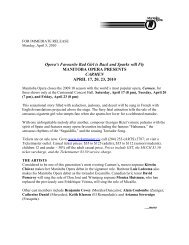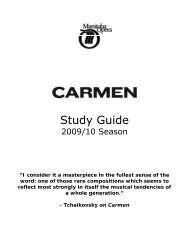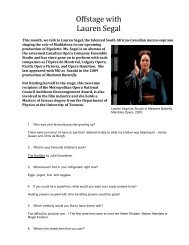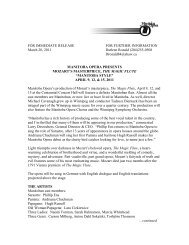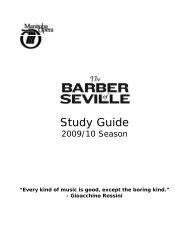La Traviata Study Guide - Manitoba Opera
La Traviata Study Guide - Manitoba Opera
La Traviata Study Guide - Manitoba Opera
Create successful ePaper yourself
Turn your PDF publications into a flip-book with our unique Google optimized e-Paper software.
ACT III<br />
In Violetta's bedroom six months later, Dr. Grenvil tells Annina her mistress has not long to live:<br />
tuberculosis has claimed her. Alone, Violetta rereads a letter from Germont saying the Baron was<br />
only wounded in his duel with Alfredo, who knows all and is on his way to beg her pardon. But<br />
Violetta senses it is too late ("Addio del passato"). Paris is celebrating Mardi Gras and, after<br />
revelers pass outside, Annina rushes in to announce Alfredo. The lovers ecstatically plan to leave<br />
Paris forever ("Parigi, o cara"). Germont enters with the doctor before Violetta is seized with a<br />
last resurgence of strength. Feeling life return, she staggers and falls dead at her lover's feet.<br />
Courtesy of <strong>Opera</strong> News<br />
What To Listen For<br />
• Un dì felice - Alfredo’s singing of his love: “I loved you from the first day… Mysterious<br />
power of love,” and Violetta’s reply.<br />
• Sempre libera degg’io - Violetta’s irresistible pledge to pleasure<br />
• The great baritone-soprano duet between the senior Germont and Violetta, which some call<br />
the quintessential Verdi duet.<br />
Listen as well for recurring themes associated with specific characters and moods in <strong>La</strong> <strong>Traviata</strong>;<br />
for example, the opening of the Prelude, played only by the violins. This represents the frailty of<br />
the heroine, Violetta. It returns again at the beginning of the last act when it connotes her<br />
impending death due to consumption.<br />
Listen to each major character’s arias and duets and hear how their words and mood are reflected<br />
in changes from major to minor keys.<br />
There was a well-established pattern in Italian opera of Verdi's time for the structure of an aria<br />
and even a duet. It followed this pattern:<br />
1) an introductory recitative to establish the dramatic and emotional situation;<br />
2) an aria in a slow or moderate tempo, known as a cavatina;<br />
3) an episode in which the situation changes--either a messenger brings important news or a<br />
decision is made;<br />
4) a fast and vigorous aria, known as a cabaletta, usually repeated after a brief intervening<br />
segment for chorus or secondary singer.<br />
13



